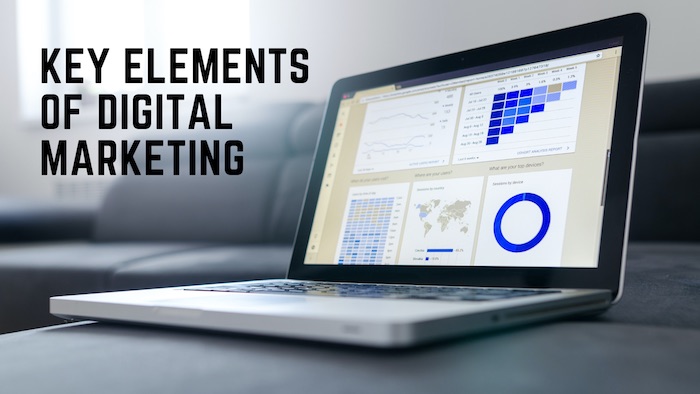Also Interesting
7 Basic Key Elements of Digital Marketing

Did you know that nearly half of all companies use digital marketing to promote their business online? Digital marketing strategies drive significantly higher revenue than traditional marketing. The benefits are innumerable.
If you don’t use digital marketing currently, you are missing out on potential leads and returns. You can get help from the best digital marketing companies to learn about these strategies. You can also enhance your digital marketing skills by learning about the seven best key elements of digital marketing mentioned in this article—
Building a Powerful Website
A powerful website is the best marketing asset to have. Having a user-friendly website helps to generate leads and increase product sales. The best digital marketing companies provide specialized tools to build powerful websites. To build a powerful website, focus on the following four aspects—
- Secure your website—Website security is a search ranking factor. Unsecure websites always have the danger to get hacked. Your website should be ‘HTTPS’ instead of ‘HTTP’.
- Minimize the loading time–Google analytics shows that a loading time of three seconds is an optimum time for users to stay on your website for a longer time. Therefore, it is crucial to minimize the loading time of your website.
- Make it mobile-friendly—These days people prefer to browse through their phone. The mobile website traffic now outpaces desktop web traffic. This is the reason you must focus on building a mobile-friendly website.
- Good web design—A clean interface with easy-to-use design features enhances user experience. Your web design should look good and add value to your customers.
Search Engine Optimization
Search engine optimization is the foundation for successful digital marketing. It is one of the most crucial marketing strategies designed to boost your ranking on the search engine results page. When your website ranks at the top of the online search results page, it opens up an opportunity to attract more qualified leads.
SEO is a long-term marketing strategy. Therefore, it requires regular upkeep to maintain high rankings. The best digital marketing companies hire SEO specialists to optimize websites, content, and social media profiles to rank higher in the search results. Higher search rankings translate into more leads and improve conversion rates for the company.
Email Marketing
Email marketing is one of the oldest yet effective lead nurturing strategies. This marketing tool allows you to follow up with potential customers and send them information about discount offers and product sales.
You can personalize your emails based on the user’s interests and deliver valuable content that may resonate with them. The best digital marketing agencies provide efficient email marketing services to cater to the needs of your customers. They also provide email automation services to make the customer journey smooth.
Video Marketing
As the name suggests, video marketing uses captivating video content to engage the audience. This strategy is incredibly effective. Google analytics show that a video is 50 times more likely to get organic leads than regular text content.
A well-structured video can help to communicate your brand’s message more effectively and impact the customer to purchase the product. You can build a strong customer base by posting valuable video content on social platforms.
Social Media Marketing
Social media marketing is one of the essential strategies of digital marketing. Most online brands take leverage of this strategy to scale their business. Today, 70% of the people worldwide use social media for customer service.
Social media marketing allows you to develop strong relationships with existing and potential customers. Moreover, it is the best platform to communicate your brand’s message to the audience, answer their queries, and sell your products. It is the most effective way to provide value to your audience and turn them into loyal customers. You can get help from the best digital marketing companies to scale your business through social media marketing. These social media marketing agencies specialize in providing tools and services that are customized to your needs.
Pay per Click Ads
Pay-per-click advertising is one of the powerful marketing strategies for maintaining a presence in search results. You may establish organic rankings with the help of SEO. However, pay-per-click ads help to boost your visibility online. Additionally, Pay per click ads gives you quick results. They help to drive qualified leads to your website as soon as you release your ad online.
Other benefits of pay per click advertising include –
- Budget-friendly – You only pay when people click your ads
- PPC offers an advanced audience targeting feature
Marketing Automation
Marketing automation reduces the workload and allows you to accomplish various tasks with ease. It is one of the most powerful marketing strategies that help to create lead generation funnels. For example, automation tools take out customer information from the CRM software, informing you about new leads. Moreover, it sends follow-up emails to nurture them.
Conclusion
To grow your business online, you need to dip your toes into the marketing component. Strategies like pay-per-click ads, email marketing, video, and social media marketing help to expand your business exponentially.
The above marketing strategies are the fundamental elements of digital marketing. Enhance your skills by learning about these strategies and boost your presence online. You can also get help from the best digital marketing companies to build strong marketing campaigns.
Also Interesting
The bizarre story of Taro Tsujimoto

The National Hockey League (NHL) has seen its fair share of strange moments, but few compare to the bizarre and hilarious tale of Taro Tsujimoto, a player who never existed. His “selection” in the 1974 NHL Draft remains one of the most legendary pranks in hockey history. If you want to wager on actual players, making the 1xBet app download is definitely a great idea.
In the 1970s, the NHL Draft was a much less glamorous event than today. It was a tedious process conducted over the phone, with teams calling in their picks. The 3 biggest highlights of what happened during that year’s draft were:
- the draft dragged on for hours;
- there were multiple rounds and teams selecting unknown prospects from obscure leagues;
- frustrated with the monotony, Buffalo Sabres general manager Punch Imlach decided to have a little fun.
As the 11th round approached, Imlach instructed his team’s representative to draft Taro Tsujimoto, a supposed forward from the Tokyo Katanas of the Japan Ice Hockey League. The name sounded authentic enough. The league officials, unfamiliar with Japanese hockey, accepted the pick without question. By downloading the 1xBet app you will also be able to wager on great NHL teams too.
A small problem
There was a small problem with all of this, as 2 things didn’t exist: Tsujimoto and the Tokyo Katanas. Imlach had completely fabricated the player as a joke, taking advantage of the NHL’s lack of verification. When it comes to NHL wagers, there is no better platform than the 1xBet Canada site.
For weeks, the league listed Tsujimoto as an official draft pick, and even some newspapers reported on Buffalo’s mysterious new Japanese prospect. Eventually, the Sabres admitted the hoax, and the NHL was forced to retroactively erase the selection from its records.
Despite being a fictional player, Taro Tsujimoto took on a life of his own. Buffalo Sabres fans embraced the prank, and over the years, his name has become a cult legend in hockey culture. Some fans even wore jerseys with “Tsujimoto” on the back. The joke persisted so much that when EA Sports released NHL video games, players could occasionally find Tsujimoto in the game’s draft pool as a hidden Easter egg.
More than just a prank, the story of Taro Tsujimoto highlights 2 things: the quirks of old-school sports management and the creativity of one of hockey’s most colorful executives. Today, with the draft process being highly scrutinized and broadcast live, such a prank would be impossible. But Tsujimoto’s legacy lives on as one of hockey’s greatest inside jokes. What is not a joke are the great rewards that a platform like the Canadian 1xBet site can give you.
Also Interesting
60% of Canadians gamble each month – why the industry is going from strength to strength

When it comes to regulating gambling, Canada has a somewhat relaxed approach. The Canadian Gaming Association oversees the industry, but it’s up to individual provinces to enact and enforce any laws relating to online casino gaming, sports betting, traditional casino gaming, and other forms of gambling.
Canada’s online casino gaming laws are not totally clear, but individual provinces are starting to put this right. Ontario was the first and did so when it launched its own regulated igaming market in April 2022. Now some other provinces have followed suit, creating a safer igaming environment for players in those provinces. Below is a look at gambling in Canada compared to other parts of the world, at gaming laws in Alberta compared to other provinces, and at the future of the Canadian, US, and UK gambling industries.
Canada: a forever love of gambling
Gambling in some form or other has always been popular in Canada. Way back in the 1990s, research found six in ten Canadians (60%) gambled every month. Additionally, four in ten (43%) spent between 1 and 20 Canadian dollars on gambling. Fast forward to today and the Canadian gambling market is worth 14.2 billion US dollars as of January 2024, according to data on the website of consumer and market data company Statista.
It seems Canada enjoys wagering just as much as two other countries that love a gamble: the US and the UK. Data on the Statista website shows that 49% of US adults took part in gambling activities in 2023. Fifty-six percent said their attitude towards gambling had relaxed, compared to the 50% of 2019.
The UK returned similar stats for the same year. Forty-eight percent of adults reported engaging in gambling activity. Online casinos generated the most gross gambling yield in 2023, but it was the nation’s National Lottery that people played the most.

Alberta: following Ontario’s lead
The regulatory developments in Ontario have triggered movement in Alberta. In May 2024, Bill 16, the Red Tape Reduction Amendment Act, made it through the process and later received Royal Assent to become law. The act removes the monopoly of gaming by a single government entity and will allow private operators, licensed by Alberta’s provincial regulator, to provide online gaming services in Alberta, meaning players will have a choice of more than one Alberta online casino to play at.
The regulation transforms Alberta into one of the more liberal provinces when it comes to online gambling, others being Quebec, Ontario, and British Columbia.
Several provinces, such as Novia Scotia and Northwest Territories, have no provincially regulated online gaming sites. Some also restrict betting on horse racing and/or other types of sports betting, obliging citizens to use international betting sites for freedom from caps and betting on as many events as they wish.

What lies ahead for the Canadian, US, and UK gambling industries?
Canada’s appetite for gambling is clear, and the industry’s online sector is beginning to thrive. Ontario has enjoyed vast success by creating its own regulated market, one which, in just its first year, saw Canadians place billions in wagers and the industry itself generate more than a billion in total gaming revenue.
Canada can expect to see other provinces follow Ontario’s lead and allow private operators to provide services in the province under license. The purpose of the regulation is player protection. Any province that develops a regulated market will focus on this, so there will also be regulations around the advertising of gambling services.
The US
Gambling online is the future for the US, too, although states are slow to legalize it. As of September 2024, 38 states had legalized sports betting, following the US Supreme Court’s ruling that states could regulate sports gambling directly.
Despite allowing sports betting, some states only permit in-person betting, and only a few states allow online casino gaming. Operators believe online casino gaming is the future of gambling.
The UK
In the UK, the use of artificial intelligence (AI) will get bigger and bigger. Companies have realized AI can enhance players’ experience and are embracing it more and more. For instance, sports betting websites can use it to crunch data and provide iGamers with stats and other data to make better betting decisions. They’re also understanding they can use AI to prioritize content players are likely to be interested in and to personalize their offerings and services to players’ preferences.
Canada enjoys gambling as much as America and the UK. Although laws around igaming are more of a grey area in Canada, some provinces are clearing the issue up by creating regulated markets and experiencing great success. As time goes by, more are sure to follow.
-

 COVID-192 days ago
COVID-192 days ago17-year-old died after taking COVID shot, but Ontario judge denies his family’s liability claim
-

 2025 Federal Election2 days ago
2025 Federal Election2 days ago2025 Federal Election Interference from China! Carney Pressed to Remove Liberal MP Over CCP Bounty Remark
-

 2025 Federal Election2 days ago
2025 Federal Election2 days ago2025 Election Interference – CCP Bounty on Conservative Candidate – Carney Says Nothing
-

 2025 Federal Election2 days ago
2025 Federal Election2 days agoPoilievre on 2025 Election Interference – Carney sill hasn’t fired Liberal MP in Chinese election interference scandal
-

 2025 Federal Election24 hours ago
2025 Federal Election24 hours agoJoe Tay Says He Contacted RCMP for Protection, Demands Carney Fire MP Over “Bounty” Remark
-

 2025 Federal Election1 day ago
2025 Federal Election1 day agoHong Kong-Canadian Groups Demand PM Carney Drop Liberal Candidate Over “Bounty” Remark Supporting CCP Repression
-

 Aristotle Foundation2 days ago
Aristotle Foundation2 days agoCanada has the world’s MOST relaxed gender policy for minors
-

 Censorship Industrial Complex2 days ago
Censorship Industrial Complex2 days agoWelcome to Britain, Where Critical WhatsApp Messages Are a Police Matter





